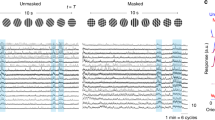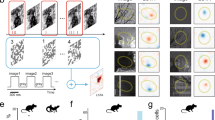Abstract
THE threshold contrast of object detail decreases with increasing size; the full curve of Fig. 1 shows the threshold contrast of circular object details as a function of their angular diameter1. To explain the form of this function some2–4 have proposed that noise is less effective in “obscuring” the larger details; others5,6 have suggested that the contrast loss in the optical and neural processes is less for the larger details. This fundamental uncertainty has not yet been resolved7. According to the first view, noise is sampled over the equivalent area of the object detail. Because a larger number (N) of random events would be integrated in a larger detail area, the relative standard deviation (N−½) would be less, and would in fact be inversely proportional to the detail diameter (Fig. 1, dotted line). According to the second view, the “obscuring” effect of the noise is constant for different diameters of object detail, and the form of the contrast threshold function results solely from variation in the contrast loss. The loss arises from imperfections in the optical and the neural processes. The contrast loss may be quantitatively described in terms of a contrast transfer function. For the present purpose, this is defined as the ratio of the subjective brightness contrast to the objective luminance contrast of the object detail, expressed as a function of detail diameter. Both contrasts refer to the centre of the detail in relation to its background.
This is a preview of subscription content, access via your institution
Access options
Subscribe to this journal
Receive 51 print issues and online access
$199.00 per year
only $3.90 per issue
Buy this article
- Purchase on Springer Link
- Instant access to full article PDF
Prices may be subject to local taxes which are calculated during checkout
Similar content being viewed by others
References
Blackwell, H. R., J. Opt. Soc. Amer., 36, 624 (1946).
de Vries, Hl., Physica, 11, 179 (1943).
Rose, A., Proc. Inst. Radio Eng., 30, 295 (1942).
Rose, A., J. Opt. Soc. Amer., 38, 196 (1948).
Morgan, R. H., Amer. J. Roentgetnol. Radium Ther. Nucl. Med., 93, 982 (1965).
Dupy, O., Vision Res., 8, 1507 (1968).
Hay, G. A., Nature, 211, 1380 (1966).
Ratliff, F., Mach Bands (Holden-Day, San Francisco, 1965).
Gubisch, R. W., J. Opt. Soc. Amer., 57, 407 (1967).
Campbell, F. W., and Gubisch, R. W., J. Physiol., 186, 558 (1966).
Author information
Authors and Affiliations
Rights and permissions
About this article
Cite this article
HAY, G., CHESTERS, M. Limiting Factors in Threshold and Suprathreshold Vision. Nature 228, 1216–1218 (1970). https://doi.org/10.1038/2281216a0
Received:
Revised:
Issue Date:
DOI: https://doi.org/10.1038/2281216a0
Comments
By submitting a comment you agree to abide by our Terms and Community Guidelines. If you find something abusive or that does not comply with our terms or guidelines please flag it as inappropriate.



